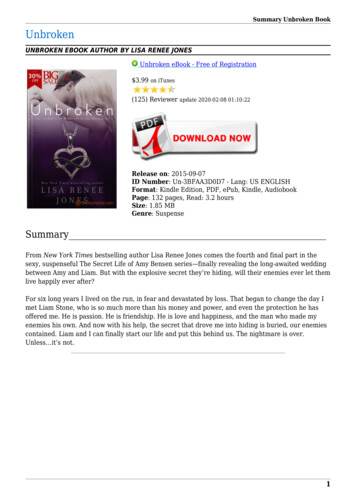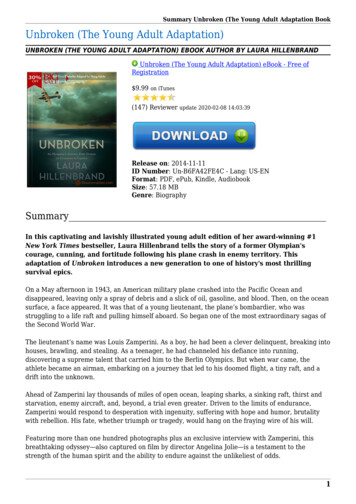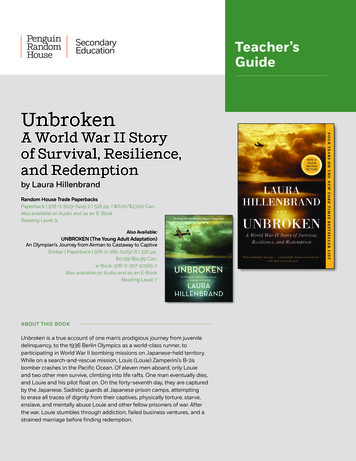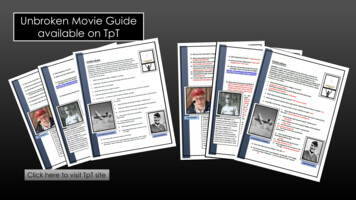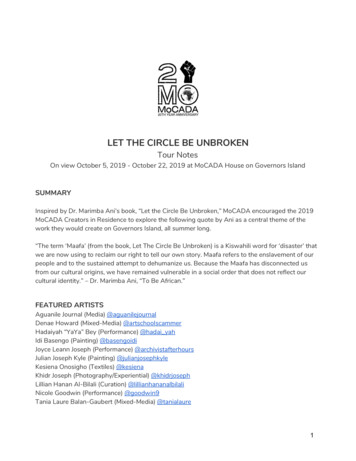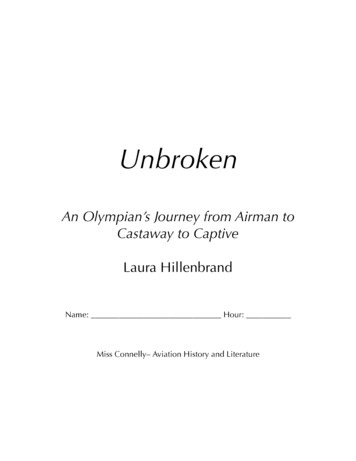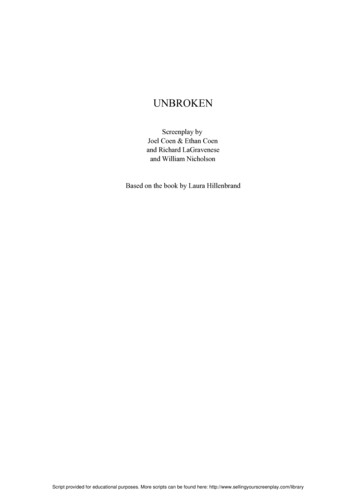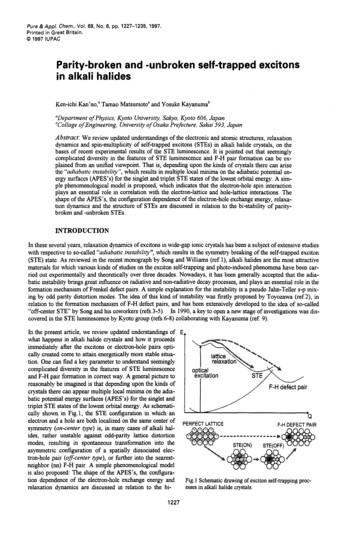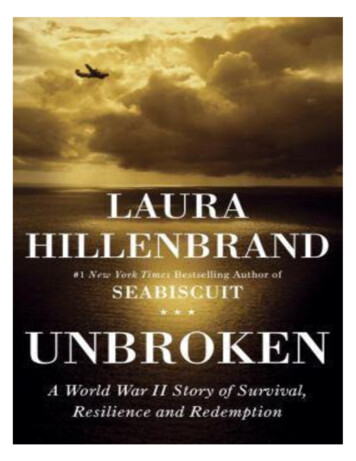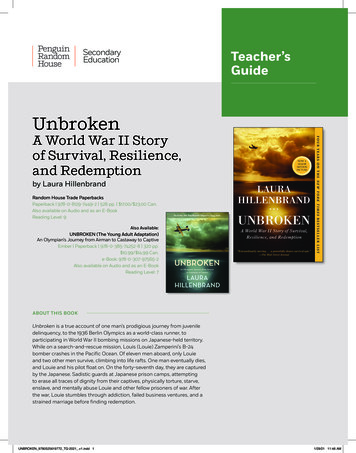
Transcription
SecondaryEducationTeacher’sGuideUnbrokenA World War II Storyof Survival, Resilience,and Redemptionby Laura HillenbrandRandom House Trade PaperbacksPaperback 978-0-8129-7449-2 528 pp. 17.00/ 23.00 Can.Also available on Audio and as an E-BookReading Level: 9Also Available:UNBROKEN (The Young Adult Adaptation)An Olympian’s Journey from Airman to Castaway to CaptiveEmber Paperback 978-0-385-74252-8 320 pp. 10.99/ 14.99 Can.e-Book: 978-0-307-97565-2Also available on Audio and as an E-BookReading Level: 7ABOUT THIS BOOKUnbroken is a true account of one man’s prodigious journey from juveniledelinquency, to the 1936 Berlin Olympics as a world-class runner, toparticipating in World War II bombing missions on Japanese-held territory.While on a search-and-rescue mission, Louis (Louie) Zamperini’s B-24bomber crashes in the Pacific Ocean. Of eleven men aboard, only Louieand two other men survive, climbing into life rafts. One man eventually dies,and Louie and his pilot float on. On the forty-seventh day, they are capturedby the Japanese. Sadistic guards at Japanese prison camps, attemptingto erase all traces of dignity from their captives, physically torture, starve,enslave, and mentally abuse Louie and other fellow prisoners of war. Afterthe war, Louie stumbles through addiction, failed business ventures, and astrained marriage before finding redemption.UNBROKEN 9780525619772 TG-2021 .v1.indd 11/29/21 11:46 AM
Teacher’s Guide for Laura Hillenbrand’s UnbrokenABOUT THE AUTHORNOTE TO THE TEACHERSLAURA HILLENBRAND, born on May 15, 1967, in Fairfax, Virginia, attended KenyonCollege in Ohio. After college she began writing articles and essays for The NewYorker, Vanity Fair, The New York Times and other publications. Her article “A SuddenIllness,” written for The New Yorker, won the National Magazine Award in 2004.Unbroken is her second work of nonfiction. The book was hailed by Time magazine asthe number one nonfiction book of the year in 2010. It also won, among other awards,the Los Angeles Times Book of the Year Award. Both Unbroken and her first nonfictionwork, Seabiscuit, spent weeks at number one on the New York Times bestseller list.Hillenbrand has received the Book Sense Book of the Year Award for Nonfictionand was nominated for the National Book Critics Circle Award for Nonfiction forSeabiscuit. In addition, Seabiscuit inspired the 2003, Academy Award-nominatedmovie of the same name. In 2014, Universal Pictures released a film adaptation ofUnbroken, directed by Angelina Jolie.Hillenbrand’s account of one man’s monumental highs and colossal lows providesa vivid portrait of life as a soldier and prisoner of war (POW) during World War II. Thebook focuses on the role of family, the bonds of friendship, and the power of hope asimportant coping mechanisms in dire situations. The author also explores the role ofphysical and mental conditioning in human resilience and in human depravity.Beyond this, Unbroken is also a powerful informational text, as it tells Louie’s storyagainst the backdrop of major world events of the twentieth century. Louie, theyounger son of a poor family, grows up during the Great Depression. Just before itsonset, Louie scrambles outside predawn to witness the German Graf Zeppelin flyover their California home on its 1929 trip around the world. He participates on theUS Olympic track team (with sprinter Jesse Owens) in Hitler’s 1936 Berlin Olympics.Louie’s military experience is determined by the fallout of December 7, 1941 (theattack on Pearl Harbor), horrific Japanese POW camps, and the atomic bombing ofJapan. He and other former prisoners of war struggle through physical and mentalpostwar torments as the 1951 Treaty of Peace between Japan and the Allied nations,which absolves Japanese war criminals, is signed. Evangelist Billy Graham plays anintegral role in Louie’s redemption. Louie’s return to the 1998 Winter Olympics inNagano, Japan, as the torchbearer, brings his storied life full circle.Supporting the national Common Core State Standards (CCSS) in readinginformational text for high school curriculums, Unbroken is an appropriate selectionfor grades eleven and twelve in Language Arts or US History classes. At the collegelevel, the book is appropriate for US History and Military History courses, and is alsoideal for first-year/common reading programs.In the following “Examining Content Using Common Core State Standards” sectionof this guide, the prompts provide for a critical analysis of Unbroken using theCommon Core State Standards for Informational Text for grades eleven and twelveand are organized according to the standard they primarily support. In addition, atthe end of each standard and the corresponding prompts, a classroom activity isprovided that will enhance analysis of the text.For a complete listing of the Standards, go to: www.corestandards.org/the-standards.2UNBROKEN 9780525619772 TG-2021 .v1.indd 21/29/21 11:46 AM
Teacher’s Guide for Laura Hillenbrand’s UnbrokenEXAMINING CONTENT USING COMMON CORE STATE STANDARDSThe author’s Notes section, beginning on page 417, is an excellent resource for furtherexamination of many of the following prompts.KEY IDEAS AND DETAILSn CCSS ELA-LITERACY.RI.11-12.1 Cite strong and thorough textualevidence to support analysis of what the text says explicitly as well asinferences drawn from the text, including determining where the textleaves matters uncertain.1. How did the Graf Zeppelin’s passengers describe the shadow? What inferencescan be drawn from the shadow’s description and Louie Zamperini’s life? Howdoes this description foreshadow events leading up to the inception of WorldWar II as well as events in Louie’s life?2. Compare and contrast Louie’s view of running as “one more constraint”(Chapter Two, p. 15) with his self-encouragement, “let go” (Chapter Three, p. 35),while running in the 1936 Berlin Olympics. What had constrained Louie?3. As the Green Hornet spiraled downward, Phil thought, “There’s nothing moreI can do,” which left him “strangely devoid of fear.” (Chapter Eleven, p. 124)Louie felt “intensely alive,” even though he knew the plane was doomed.(Chapter Eleven, p. 125) Analyze these feelings. What is the author’s purpose forincluding them? Compare Phil’s and Louie’s thoughts and actions with those ofMcNamara.4. In Chapter Twenty-Three, the reader is introduced to Corporal MutsuhiroWatanabe, who embraces the philosophy of nihilism. Research nihilism andexamine the Corporal’s application of its tenets. A website source can be foundat tiny.cc/Nihilism.5. John Falconer described bombed-out Hiroshima as a beautiful sight. (ChapterThirty-Three, p. 327) Examine why Falconer, in the immediate aftermath ofhis hellish POW experience, would feel this way. Video of the aftermath ofHiroshima and Nagasaki can be viewed at tiny.cc/AtomBomb.CLASSROOM ACTIVITYAfter studying the positions of each soldier aboard the Superman and the GreenHornet, have students watch a video clip of a World War II air battle. As studentsexperience the sights and sounds of World War II air combat, ask them to write streamof-consciousness poems describing their feelings and actions as if aboard a combatplane that is spiraling out of control. What impromptu measures would they take tostay alive/prepare for death?n CCSS ELA-Literacy.RI.11-12.2 Determine two or more central ideas of atext and analyze their development over the course of the text, includinghow they interact and build on one another to provide a complexanalysis: provide an objective summary of the text.1. The Preface to Unbroken recounts an encounter with a Japanese war planestrafing World War II Army Air Force Bombardier Louis Zamperini and his twocrewmates, who are adrift in life rafts in the Pacific Ocean. As the Japanese Zerotargets the drifters on yet another pass, machine guns blazing, Louie dives for3UNBROKEN 9780525619772 TG-2021 .v1.indd 31/29/21 11:46 AM
Teacher’s Guide for Laura Hillenbrand’s UnbrokenCLASSROOM ACTIVITY(CONTINUED)cover under his raft only to notice the presence of sharks coiling upward fromthe depths. As you read Unbroken, examine how this crisis and its resolutionsymbolize most of Louie’s life, especially in terms of the role of physical andmental conditioning in human resilience.2. Compare/contrast the personalities of Louie and Pete. In addition, examine therole Louie’s family plays in Louie’s ability to maintain hope against seeminglyinsurmountable odds.3. As Louie ran the 5,000-meter final in the 1936 Berlin Olympics, he recalleda comment Pete once made: “A lifetime of glory is worth a moment of pain.”(Chapter Three, p. 35) Then, in Louie’s words, he “let go.” (p. 35) In manyways Unbroken is about the experience of letting go. For some, like FrancisMcNamara (Mac), letting go meant succumbing to death. (Chapter 16, p. 171)Develop a position paper, citing further examples from the book that addresseswhat human qualities and conditions are essential to remain resilient againstthe odds.4. Consider the qualities of exceptional leaders. Did Louie demonstrate goodleadership in Unbroken, especially while lost at sea? Support your position usingexamples from the book and other reputable resources.5. Analyze the role the mothers of Louie Zamperini and Mutsuhiro Watanabeplay in the lives of their sons. Cite examples from the text that support theirdedication to their sons. In what ways were their actions similar and in whatways were they different?CLASSROOM ACTIVITYSome say that survival is 80% mental (keeping a positive attitude), 10% skill(knowledge), and 10% equipment (specialized resources). (See the Montclair Collegewebsite below.) While adrift in the Pacific, Louie takes stock of the rafts’ survivalprovisions. (p. 133) He improvises the use of these items to save Phil, Mac, and himself.(p. 164) Conduct a problem-solving survival scenario using groups of four or five. Adaptthe sea/wilderness survival experiential learning activities from the websites below tomeet the developmental needs of students engaged in the reading of Unbroken:Lost at Sea Lesson Plans (COSEE): www.cosee-central-gom.org/seascholars/lesson plans/cruisin/lostatsea lesson.html(The above site provides for a time line for written analysis—a Common Core State Standards requirement.)Survival Lesson Plan (Monclair State University): tiny.cc/SurvivalLessonPlanBasic Survival Skills (Alderleaf Wilderness College): mlThree Things Required for Survival in Any Situation tuation/n CCSS ELA-LITERACY.RI.11-12.3 Analyze a complex set of ideas orsequence of events and explain how specific individuals, ideas, orevents interact and develop over the course of the text.1. While reading Unbroken, create a character chart on Louie and on MutsuhiroWatanabe. Log their thoughts, plans, words, feelings, deeds, actions, strengths,and weaknesses. Then, analyze the relationships and events that cause themto change over time. In what ways do they remain unchanged? Janet Allen’s4UNBROKEN 9780525619772 TG-2021 .v1.indd 41/29/21 11:46 AM
Teacher’s Guide for Laura Hillenbrand’s UnbrokenCLASSROOM ACTIVITY(CONTINUED)Yellow Brick Roads (Portland, MA: Stenhouse Publishers, 2000) providescomprehensive character chart graphic organizers.2. In Chapter Nineteen, the author quotes from the 1941 Japanese Military FieldCode that soldiers should die, rather than live with the shame of imprisonment.Read more excerpts from the Japanese Military Field Code at tiny.cc/FieldCode.Analyze the ideal Japanese soldier based on the contents of this code, includinghow he was to treat captives. Compare and contrast the ideal with the Japanesesoldiers described in Unbroken.3. In Chapter Twenty-Four, the reader is introduced to Japanese Private YukichiKano. Kano aids as many POWs in Omori as he can, risking his own life. Medalof Honor recipient Pappy Boyington wrote, “’[His] heart was being torn outmost of the time, a combination of pity for the ignorance and brutality of someof his own countrymen and a complete understanding of the suffering of theprisoners.” (p. 251) In his own way, Kano resisted the regime. Develop a position asto why there was little organized resistance to the Japanese World War II regimeas compared to the European regimes. For a brief overview of Japan’s reasonfor entering the war, go to tiny.cc/JapanWWII. Also, Leaves from the Autumnof Emergencies: Selections from the Wartime Diaries of Ordinary Japanese, bySamuel Yamashita, and Hiroshima, by John Hersey provide human perspectiveson the daily lives of ordinary Japanese citizens during the war.4. Throughout Unbroken, the author describes the brutality of Japanese prisonpersonnel toward their captives. Compare this treatment with the Nazitreatment of prisoners of war. Develop a position as to which Axis power wascrueler. Support your conclusions using examples from the book and otherreputable sources. Hillenbrand cites a number of references on page 448 of theNotes section of Unbroken. In addition, ask students to search online for WorldWar II prisoners of war data.CLASSROOM ACTIVITYDebate Option One: American POWs in Japanese prison camps were subjectedto waterboarding as a means of obtaining classified enemy information. Researchthe technique of waterboarding, including its use by United States intelligenceagencies. Conduct a classroom debate concerning whether or not waterboarding is aninterrogation tool or a form of torture. This debate activity can be extended to introduceand discuss interrogation methods in other countries.Debate Option Two: In the Epilogue, the author delineates the reasons the UnitedStates lifted the retribution of Japanese war criminals. Discuss those reasons, and thensupport or refute the lift using examples from the book and other reputable sources.ccss: craft and structureCRAFT AND STRUCTUREn CCSS.ELA-LITERACY.RI. 11-12.4 Determine the meaning of words andphrases as they are used in a text including figurative, connotative,and technical meanings: analyze how an author uses and refines themeaning of a key term or terms over the course of a text (e.g., howMadison defines faction in Federalist No. 10)1. According to Hillenbrand, “The same attributes that had made him the boyterror of Torrance were keeping him alive in the greatest struggle of his life.”(Chapter Fourteen, p. 155) Do you agree? Explain your position citing examplesfrom Unbroken.5UNBROKEN 9780525619772 TG-2021 .v1.indd 51/29/21 11:46 AM
Teacher’s Guide for Laura Hillenbrand’s UnbrokenCRAFT AND STRUCTURE(CONTINUED)2. As Hillenbrand describes Louie’s prison life, she explores the concept ofdignity as a basic need. (Chapter Eighteen, p. 188) Critique the role of dignityas an essential element to life.3. Evaluate the phrase, “ . . . They remained sovereign over their own souls.”(Chapter Twenty-Two, p. 233) Support its relevance to the human conditionusing events from Louie’s life as well as other people described in Unbroken.4. At Naoetsu, Louie hauled charcoal in a basket strapped to his back whileTom Wade recited poetry and speeches. (Chapter Twenty-Eight, p. 287)Compare the recitations to the conversations Louie held with his raft mates,Phil and Mac. What purpose, if any, did the recitations serve?5. Hillenbrand writes, “. . . the Japanese commander slogged back up the mountain. . . He walked into the barracks and approached the ranking American,Lieutenant Colonel Marion Unruh.” The commander said, “The emperor hasbrought peace to the world.” (Chapter Thirty-Two, p. 315) This is how Japanesecitizens learn of the war’s end. Ask students to research how the governmentsand citizens of Germany and Japan have regarded their nations’ conductduring the war. Are their attitudes accepting? Are certain subjects taboo?6. Evaluate Louie’s statement, “This, this little home . . . was worth all of it.”(Chapter Thirty-Four, p. 341)7. Compare and contrast Louie’s actions upon meeting his captors in SugamoPrison (Chapter Thirty-Nine) with him being reunited with his mother afterhe jumped off the California-bound train. (Chapter One, p. 5)n CCSS.ELA-LITERACY.RI.11-12.5 Analyze and evaluate the effectiveness ofthe structure an author uses in his or her exposition or argument, includingwhether the structure makes points clear, convincing, and engaging.1. Unbroken is composed of a short preface, five parts, and an epilogue.Each section foreshadows the one that follows. Discuss the structure ofthis book—how one section’s cliff-hanger leads to the next’s resolution orsubsequent conflict. Discuss the author’s purpose for sectioning the book asshe does. What effect does it have on the reading experience?2. The book opens with an excerpt from Walt Whitman’s “The WoundDresser.” Read the whole poem at tiny.cc/TheWoundDresser and drawparallels between the wound-dresser’s changing attitude with Louie’stransformations in Unbroken. Examine the author’s reason for selecting theexcerpt as her epigraph to Unbroken.3. Hillenbrand makes ample use of figurative language in this book. Forexample: “In Torrance, a one-boy insurgency was born” (p. 6); “Strickenbombers began slipping behind, and the Zeros pounced” (p. 100); “The skybroke all at once. . . . The ocean began heaving and thrashing. The windslapped the raft. . . . ” (p. 177); “With the bombers sweeping overhead, the Birdstormed into the barracks and shouted for all Americans to get out. . . .The Bird and Kono picked up their kendo sticks . . . and began smashingthem [the Americans] over their heads. . . . Woozy, Louie lay there as theBird and the sirens screamed” (p. 302); and “Louie walked upstairs and laydown on his old bed. When he finally drifted off, the Bird followed him intohis dreams.” (p. 342) Discuss why the author might have chosen to use suchfigurative language in a biography. Does it help or hinder the understandingof the themes presented in this book? Explain.6UNBROKEN 9780525619772 TG-2021 .v1.indd 61/29/21 11:46 AM
Teacher’s Guide for Laura Hillenbrand’s UnbrokenCRAFT AND STRUCTURE(CONTINUED)4. Both Louie and brutal prison guard Mutsuhiro Watanabe survive into old age.After describing the Japanese World War II POWs’ liberation in Unbroken,Hillenbrand provides a detailed account of prison guard Watanabe’s survival.As you critique the survival of both Zamperini and Watanabe, consider theauthor’s purpose in including Watanabe’s survival account.n CCSS.ELA-LITERACY.RI.11-12.6 Determine an author’s point of view or purposein a text in which the rhetoric is particularly effective, analyzing how style andcontent contribute to the power, persuasiveness or beauty of the text.1. Hillenbrand considers the Japanese ideal of the superior race. (ChapterNineteen, p. 201) Compare her findings with research on Hitler’s ideologies.Which doctrine led to more violent tendencies toward prisoners of war? Supportyour answer with valid research.2. Hillenbrand writes, “Perhaps some guards forced their prisoners to live inmaximally dehumanizing conditions so that they could reassure themselvesthat they were merely giving loathsome beasts their due. . . . Some of theworst abuses . . . may have arisen from guards’ discomfort with being abusive.”(Chapter Nineteen, p. 202) Support or refute this observation using examplesfrom Unbroken as well as examples from other valid research.3. Hillenbrand describes Louie’s breakup with his beloved Cynthia in terms ofHolocaust survivor Jean Améry’s account, “All he had left was his alcohol andhis resentment, the emotion that Jean Améry would write, ‘nails every oneof us onto the cross of his ruined past.’” (Chapter Thirty-Seven, p. 374) Readexcerpts from Jean Améry’s book, At the Mind’s Limits, at ges-everything-jean.html. DoesHillenbrand ultimately support or refute Améry’s conclusions? Explain usingexamples from Unbroken.4. Hillenbrand writes that Japanese POW accounts of abuses “pushed thebounds of believability.” (Chapter Thirty-Four, p. 343) Analyze Louie’s lifestory. Does it push those bounds too? What importance does Hillenbrandplace on the role of providence in Louie’s survival? Consider Louie’scontemplations and experiences during days thirty-nine and forty on the raft(Chapter Sixteen, p. 174), and his recall of other past experiences under a BillyGraham rival tent. (Chapter Thirty-Eight, p. 382) Use additional examplesfrom Unbroken.CLASSROOM ACTIVITYINTEGRATION OFKNOWLEDGE AND IDEASHave students compose and share “Six Word Memoirs” (explanation below) basedon Louie’s experiences at each stage of his life. In addition, have students create andshare “Six Word Memoirs” based on themes addressed in Unbroken. Culminate byhaving students expand their memoirs into formal essay format using textual supportand other reliable resources. For a guide on implementing “Six Word Memoirs,” s-guide-teen-book.pdf.n CCSS.ELA-LITERACY.RI.11-12.7 Integrate and evaluate multiple sourcesof information presented in different media or formats (e.g., visually,quantitatively) as well as in words in order to address a question orsolve a problem.7UNBROKEN 9780525619772 TG-2021 .v1.indd 71/29/21 11:46 AM
Teacher’s Guide for Laura Hillenbrand’s UnbrokenINTEGRATION OFKNOWLEDGE AND IDEAS(CONTINUED)1. Chapter One begins with Louie watching, awestruck, as the Graf Zeppelinpasses over his California home on the last leg of its around-the-world journey.Examine the author’s purpose for juxtaposing the vessel’s passage with theevents that occurred in the countries it passed over. Further analyze theauthor’s purpose for including this event at the outset of her account of Louie’slife. In addition, access the materials Hillenbrand used to document the GrafZeppelin—especially Douglas Botting’s work, Dr. Eckener’s Dream Machine. Amap of the Graf Zeppelin’s 1929 journey can be found at tiny.cc/GrafZeppelin.2. Analyze how Louie’s brush with eugenics affected him. Go to tiny.cc/EugenicsAndTheNazis and read an article by Edwin Black, “Eugenics andthe Nazis—the California Connection,” San Francisco Chronicle, November 9,2003. Develop a position on the embrace of eugenics in some parts of theUnited States. For further reference, a brief description of the inception of NaziGermany’s euthanasia program can be viewed in a clip of director Peter Cohen’sdocumentary Architecture of Doom Nazi Eugenics at tiny.cc/NaziEugenics.3. Study a map of the World War II Pacific Theater and describe the extent ofJapanese-controlled territory in 1942. What specific obstacles, if any, wouldmilitary strategists face in gaining control of the occupied lands?4. On Friday, June 4, 1943, Phil’s mother received a telegram announcing that Philwas missing in action. (Chapter Thirteen, p. 144) Research the Army’s presentday policy procedures for notifying the next of kin for those missing in action orkilled.How different is this new policy from the one used in 1943?5. Compare/contrast the Rickenbacker account of being lost at sea withthe castaways of the Green Hornet. The Historynet.com article at tiny.cc/Rickenbacker recounts Rickenbacker’s experience.6. Both Phil and Louie recognized the seriousness of their predicament at sea,yet neither man succumbed to hopelessness. Defend the power of the mind tohope in hopeless situations using examples from Unbroken and other sources.The following articles will help develop this theme:“The Brain: The Power of Hope” by Scott Haig, MD: tiny.cc/PowerOfHope“Intense Emotions and Strong Feelings: A Language Everyone ShouldUnderstand” by Mary C. Lamia, PhD: tiny.cc/PowerOfHope27. Read the poem “The Rime of the Ancient Mariner” by Samuel Taylor Coleridge.Compare and contrast the plight of the mariner with Louie’s plight. Coleridge’spoem can be found at tiny.cc/AncientMariner.8. Research the sex slave industry run by the Japanese during World War II.Research modern-day sex slave industries. Has an intolerance of such practicesevolved today? Explain. You may choose to begin the research at tiny.cc/ComfortWoman (a comfort woman for the Japanese describes her ordeal). Alsoresearch the 1937 Nanking massacre at the hands of the Japanese.CLASSROOM ACTIVITYAt the beginning of Chapter Thirty-One, “Naked Stampede,” the war prisoners heardand read different accounts of what happened at Hiroshima and Nagasaki. SinceWorld War II, subsequent generations have understood the ramifications of thedropping of the atomic bomb. In order for students to understand how languageand culture are in constant flux, make a list of terms and mindsets that may not beknown to the students. In groups, have the students brainstorm, and then share theirconclusions as to what the terms or mindsets mean. After revealing true meanings,8UNBROKEN 9780525619772 TG-2021 .v1.indd 81/29/21 11:46 AM
Teacher’s Guide for Laura Hillenbrand’s UnbrokenCLASSROOM ACTIVITY(CONTINUED)OTHER WORKS OF INTERESThave students make up their own lists of terms and mindsets that are a part of theirvernacular and that may not be known to older generations. Ask them to share theirresults with older family members and poll the results. In addition, have the studentscreate a list of terms and mindsets that older family members use/used that thestudents might not know or use. Students should be prepared to share their results.At the Mind’s Limits by Jean AméryEmpire of the Sun by J.G. BallardThe Sorrow of War: A Novel of North Vietnam by Ninh BaoThe Greatest Generation by Tom BrokawThe Boys in the Boat by Daniel James BrownThe Rape of Nanking by Iris ChangNarrative of the Life of Frederick Douglass by Frederick DouglassHotel on the Corner of Bitter and Sweet by Jamie FordThe Diary of a Young Girl by Anne FrankHiroshima by John HerseyMein Kampf by Adolf HitlerStrength in What Remains by Tracy KidderWe Band of Angels by Elizabeth NormanIn the Heart of the Sea: The Tragedy of the Whaleship Essex by Nathaniel PhilbrickLeaves from the Autumn of Emergencies: Selections from the Wartime Diaries ofOrdinary Japanese by Samuel YamashitaDevil at My Heels by Louis Zamperini and David RensinABOUT THIS GUIDE’S WRITERJUDITH TURNER is a longtime educator at Terrace Community Middle School inTampa, Florida. She has held Subject Area Leader positions in language arts and socialstudies. She has also served the school as an assistant principal. Ms. Turner receivedher BA in Literature and Language from the University of Wisconsin–Green Bay andher MA in Educational Leadership and Policy Studies from the University of SouthFlorida–Tampa.SecondaryEducationPenguin Random House Education1745 Broadway, New York, NY 10019PRHSecondaryEd.comQueries: ryEd@PRHSecondaryEd@PRHSecondaryEd/Penguin Random House Education9Guide Penguin Random House LLCUNBROKEN 9780525619772 TG-2021 .v1.indd 91/29/21 11:46 AM
Teacher’s Guide for Laura Hillenbrand’s UnbrokenNOTES10UNBROKEN 9780525619772 TG-2021 .v1.indd 101/29/21 11:46 AM
Teacher’s Guide for Laura Hillenbrand’s UnbrokenNOTES11UNBROKEN 9780525619772 TG-2021 .v1.indd 111/29/21 11:46 AM
Teacher’s Guide for Laura Hillenbrand’s UnbrokenNOTESSecondaryEducationPenguin Random House Education1745 Broadway, New York, NY 10019PRHSecondaryEd.comQueries: ryEd12@PRHSecondaryEd@PRHSecondaryEd/Penguin Random House EducationGuide Penguin Random House LLCUNBROKEN 9780525619772 TG-2021 .v1.indd 121/29/21 11:46 AM
Unbroken A World War II Story of Survival, Resilience, and Redemption by Laura Hillenbrand Unbroken is a true account of one man's prodigious journey from juvenile delinquency, to the 1936 Berlin Olympics as a world-class runner, to participating in World War II bombing missions on Japanese-held territory.
